In her second offering of this new series, Lone Hansen interviewed Steve Parmelee. He is an assemblage artist who draws his inspiration “from the patinas that build up on everyday utensils, the wear and erosion that affect tools, and the way an object is marked by the ages.” His recent showings were at the Bainbridge Island Museum of Art (BIMA) and the Washington State History Museum.
Hansen first discovered Parmelee’s work at the back of Barbara Burke’s van. This lead her to attend his showing at Art in the Woods. Hansen then became acquainted with Parmelee through her friendship with Diane Haddon. She also encountered his art at the Front Street Gallery, which is located in Poulsbo where Parmelee lives.
Here are excerpts from Lone’s extensive conversation with artist, Steve Parmelee. Some wording has been revised to provide further clarity.
LH: What is life as an artist like for you in this pandemic? How has it to affected you?
SP: I’ve been struggling. It’s been difficult to produce work. I thought being sequestered would give me time to create. But I’ve just struggled emotionally and [because of what’s going on] in the world. I came in thinking that all this extra time would be beneficial to creating. I was surprised that it wasn’t.
LH: Before the pandemic had you reached the point where you were making a living through your art?
SP: Not completely. I still had my day job – a contractor. Definitely not full time.
LH: So what made you want to be an artist?
SP: I was living in Washington, [working] as a graphic artist. But it didn’t feel creative. It was commercial. I was collecting all kinds of things before that. I would go to state sales and was drawn to old things. I thought I could make things, [so] I started collecting things I could repurpose.
I found this book entitled, “The Secrets of Rusty Things: Transforming Found Objects Into Art” by Michael deMeng. I had already been collecting oil cans. As soon as I finished reading it I knew this was something I wanted to do – with some of the things in my house. Not to change careers but to have fun with it. I had a mother who was fiercely creative and did things for the house – paintings, weaving, flower arranging. I inherited that.
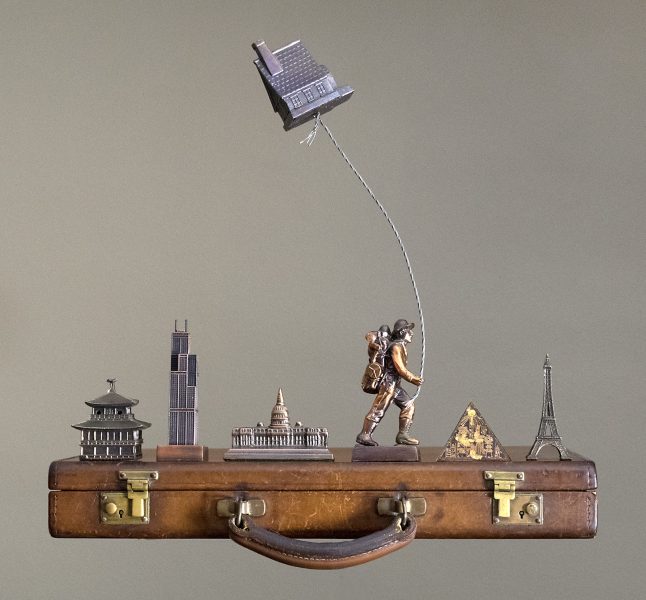
LH: Is that where you got your passion for collecting?
SP: The collecting wasn’t a family thing. It was something that really kicked in after I read that book. Knowing that there was something like salvage art I looked for it. I would go to art shows and stalk artists that did similar things. That’s how I met Diane Haddon. We met at a garage sale or a studio tour! Through our initial studio tour together, I met Kat Dubose who got me into the gallery I’m in now. I start showing at galleries. So one thing led to another. My work was getting a response, which encouraged me. I really turned it on those first three years. The studio tour led me to meet Greg Robinson at the Bainbridge Island Museum of Art, which lead to an exhibition there. Each step [directed me] to someone who was supportive, artists who were quite generous.
LH: It was quite an exhibition that you had at BIMA.
SP: Yeah. It was.
LH: How did that feel?
SP: That’s such a beautiful space, such a beautiful museum. And the people there – just so kind. I met Cynthia Sears who was supportive. I’d heard that from other artists. She came to other studio tours and started collecting my work leading up to the exhibit. Between Greg and Cynthia, I feel just so fortunate to have run into them.
LH: I want ask you about Front Street Gallery. You’re still connected with them?
SP: Yes! Thank goodness. It’s a nice community of 25 artists. Kind of like a little family. I’ve been there about seven years now and it’s right down the street. You can walk there. We’ve scaled back our hours, and there’s the mask mandate. But there’s still some foot traffic.
LH: Do you have the gallery openings?
SP: No. That’s one of the things about the pandemic. It kinda puts a wrench in the lack of events like the studio tour, or the second Saturday Artwalks, openings. Any of the social aspect is kinda lost. So it’s kinda isolating.
LH: Do you still put in hours?
SP: A couple shifts a month. Good to get out of the house for a little bit.
LH: People are coming in?
SP: They prefer the outdoors – I don’t blame them. But there are some still coming in – masked up. We have the protective shield at the register. It’s a different world.
LH: I’ve been to Front Street Gallery. It’s great.
SP: Yeah, it is. The island, North Kitsap. I’ve been treated really well.
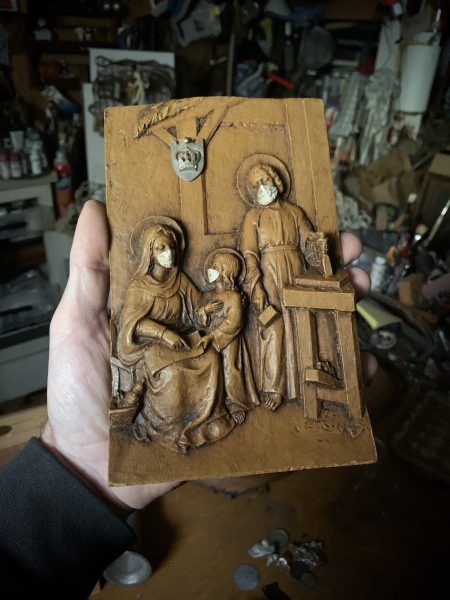
LH: Have you sold your work outside of Washington?
SP: Sure. Not through any action on my part – but through referrals or something that’s been seen online. I’m also fortunate to be in a place that draws tourists.
LH: Have you always lived in Washington?
SP: I’ve been living West – 10 years in Syracruse; 10 years in the Chicago area; 10 years in Denver. Kind of a pattern, except now I’ve been living here for 20 years.
LH: Being a graphic designer, that takes you to the next level of art.
SP: I’m aware of how much composition and contrast have been in my head from that. That repetition – it shows up in my work, I hope.
LH: It’s very balanced.
SP: Yes, thanks for that. There’s definitely a cross-over. Kat and I are both graphic designers. There’s definitely a skills-set you build just from doing that.
LH: I know you go junking with Diane Haddon…
SP: Oh, for YEARS now! Otherwise it’s such a solitary thing making art. It’s just nice to have someone who [also] does that. It’s something we can do — literally outside of scrap yards, or antique shops or garage sales. She’s a great friend.
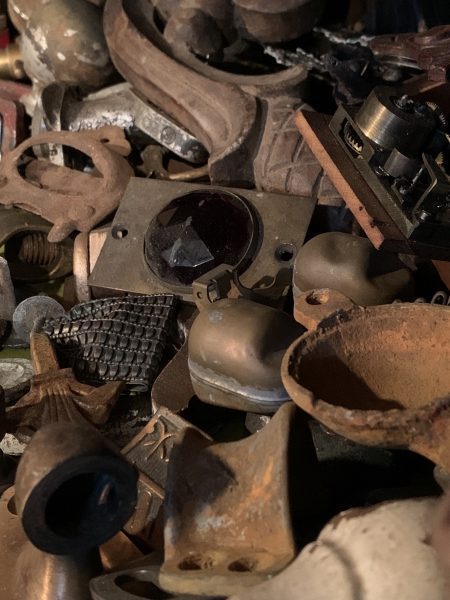
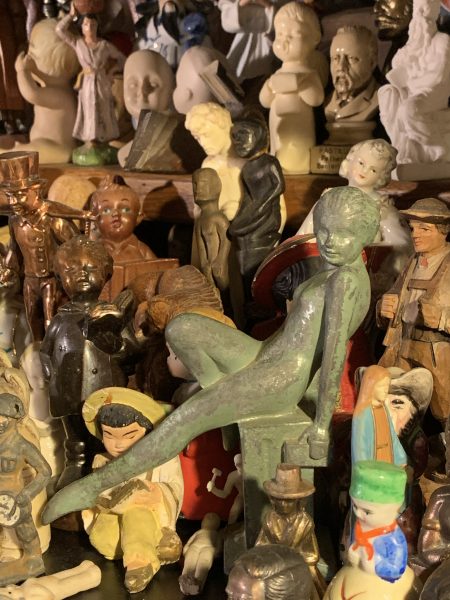
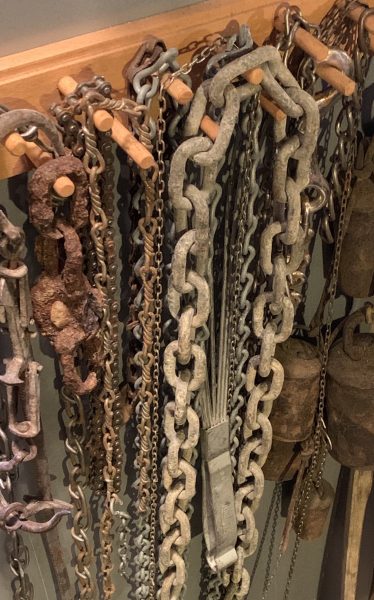
LH: I noticed that you have a lot of paint. You must paint also.
SP: I do not paint much anymore. I used to paint all my pieces, like Diane or Michael deMang. I try to leave the worn rusty look as it is as much as possible. It makes it seem as if it has more history to it. Or gravitas… Authenticity or a rawness that you don’t get. Even if you fake-paint rust it just feels more contrived. If it’s done well it looks amazing. My first 10 pieces were painted on top of the stuff that was assembled. It’s a voice that just wasn’t me. I prefer it kinda ‘au naturel.’
LH: How would you describe your process?
SP: The way I work, sometimes, it takes a lot longer, like a year or two to find the right parts. I’ll start a project or piece years ago and I revisit it as I find the pieces. Or I’ll look at a pile that I started and I notice that as time went by I’m either a different person or the times have changed. It’s weird revisiting [those pieces]. It feels like you’re collaborating with someone from the past. Or I’ll just scavenge from that piece and use other parts. [Sometimes] I’ll sit down and [work on] projects start to finish on the same day. But the ones that I started years ago and revisit feel different. Like it’s a different time.
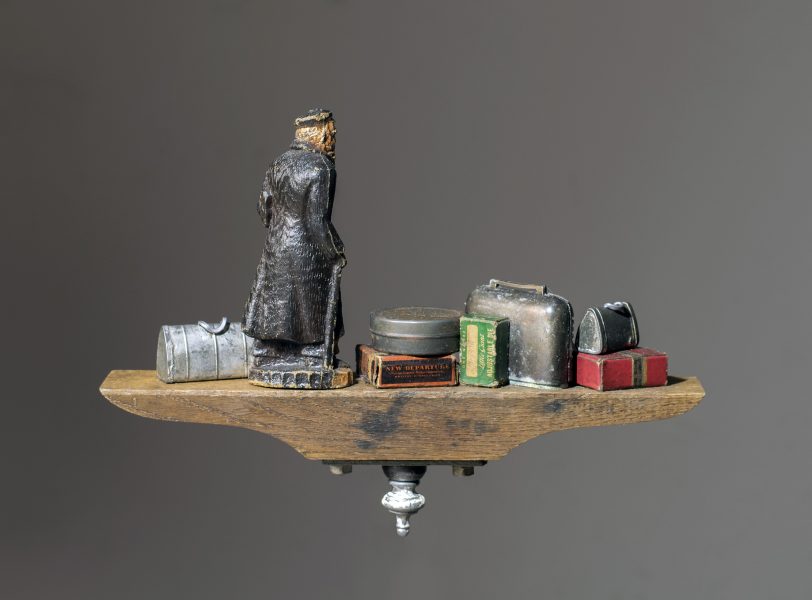
LH: What galleries have you showed at (besides BIMA)?
SP: Front Street. And Bainbridge Arts and Crafts. A little in Seattle – group shows. I’ve [also] done workshops through the Museum and through Bainbridge Arts & Crafts. I did one with Diane, which was a lot of fun.
LH: What do you do in the workshop?
SP: Create an assemblage. But in one day it’s squeezing a lot in. Usually I bring the ingredients and the tools. If they’re taking a workshop it might be their first time, so I just walk them through my thought process and also the mechanics. The gluing and the fastening. A little of the style. I wouldn’t mind doing more of that. But then Covid! We could mask up and do 6 feet… Diane and I had one planned in the spring. But it gives us time to prepare.
LH: Do you look forward to being able to create again?
SP: Absolutely. And I am. I’ve done a few Covid base pieces. I have a lot of projects in process that I come back to. And it’s also therapeutic for me, given the mechanics of actually constructing it. In my line of work there’s a lot of fastening. Everything is built. My construction background has helped.
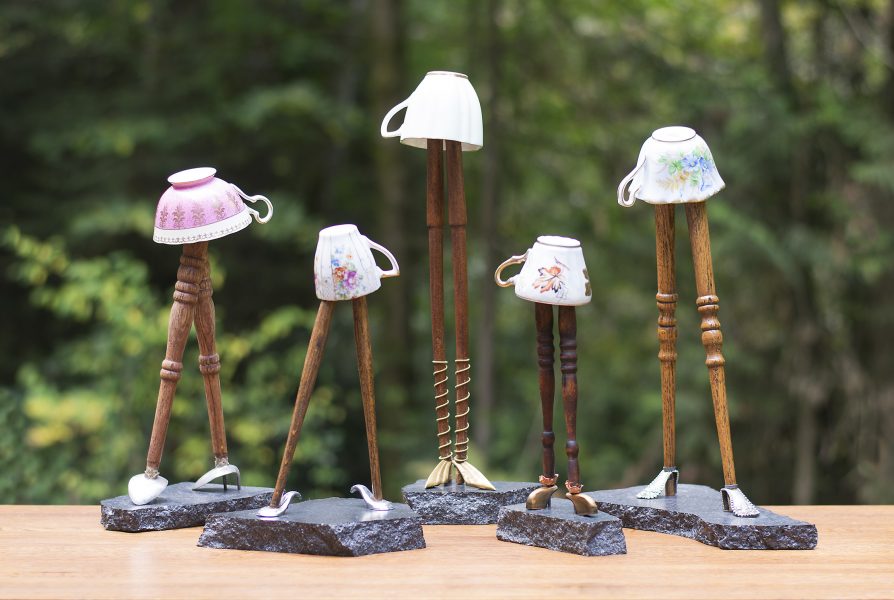
LH: Looking ahead what do you see?
SP: My forecast is just to keep creating. I’ve been collecting things. I’ve also been sketching. I wouldn’t say my work is getting darker. But it’s more political. It feels forced to go light. The sense of humor I used to put into my pieces is more forced. It’s hard to go there and feel that it’s not coming from a real [place].
I don’t mind delving into hard subjects – death, love, all the big things. This is one of them — Covid. I like the idea of taking something of a societal issue and working it in subtly. Just a wink to it, on a more personal level. You’ll see that in my work a bit.
LH: Maybe you’re changing…
SP: Yeah! I see some of the dark humor coming back. It’s a big part of my work — what I enjoy. Maybe that’s why I’ve had some stumbles getting started again.
LH: You’re not alone.
SP: I’ve commiserated with other people who’ve had that kind of a block. There’s a heaviness in the air…. I hope other artists can give themselves some grace for not having that ability right now. It’s been a challenge.
LH: What would you like to say to fellow artists?
SP: It is good therapy creating art. I want other artists to feel OK about not optimizing every minute of this lockdown and not challenging all this angst into art. I think it’s OK to give yourself some grace.
LH: What’s the best way to contact you?
SP: Through my website steveparmelee.com or through Front Street Gallery in Poulsbo.
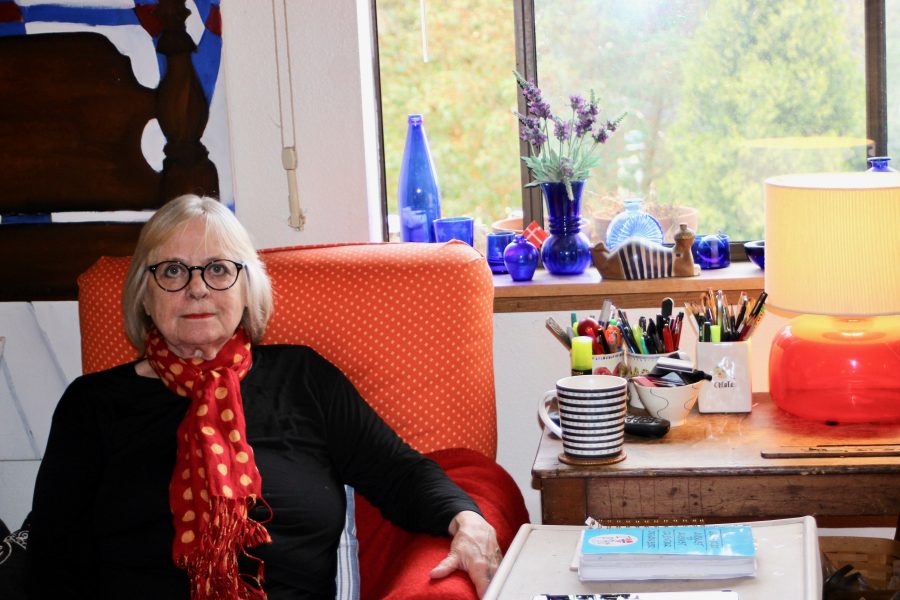
ABOUT LONE HANSEN. Lone is an artist who has owned several galleries in San Francisco, Seattle, and Bainbridge Island. She currently lives in Poulsbo where she is a member of the Poulsbo Arts League. During this pandemic and through her interactions with fellow artists, Lone has been creating art, gaining daily inspiration, cooking, and is taking care of dogs again. “I like this new normal,” she said. “It’s good for me – it is.” Lone has been “downsizing” her entire life – not just her studio, but her “whole life.” “It’s good to remember a life well lived,” she reflected. “Never boring, and it’s got me to where I am today.”